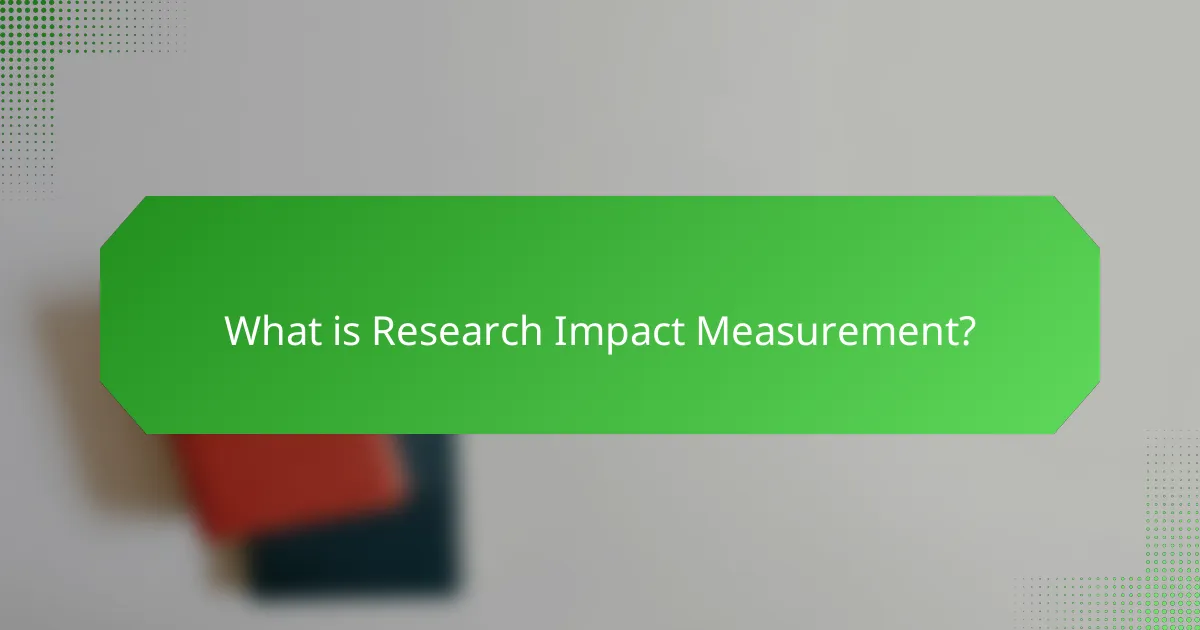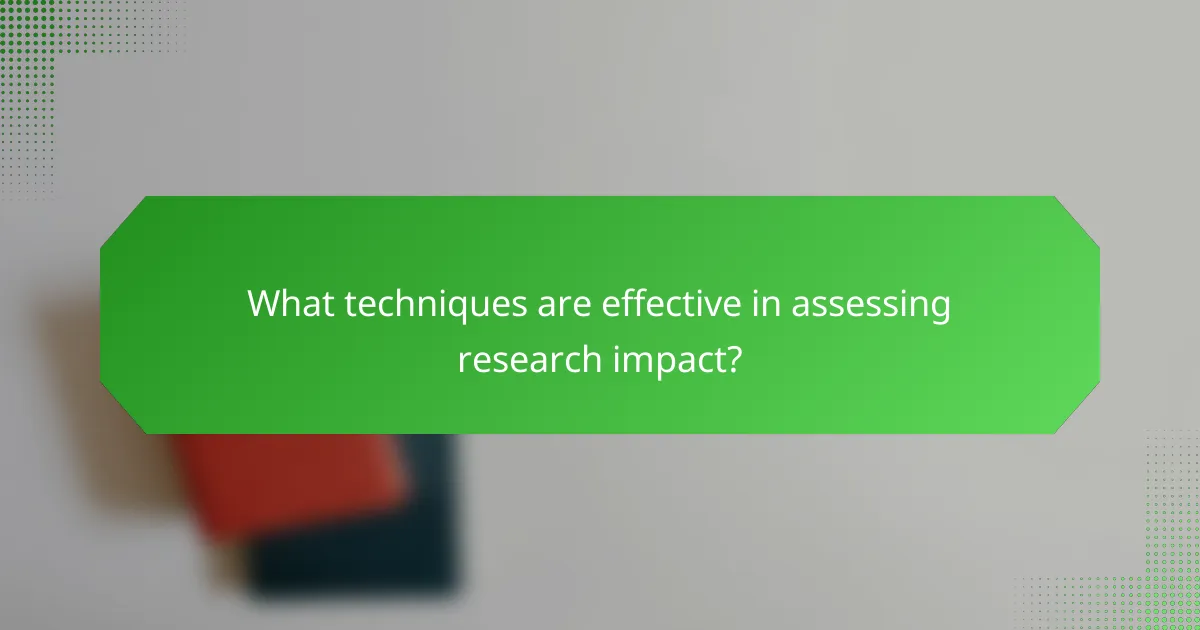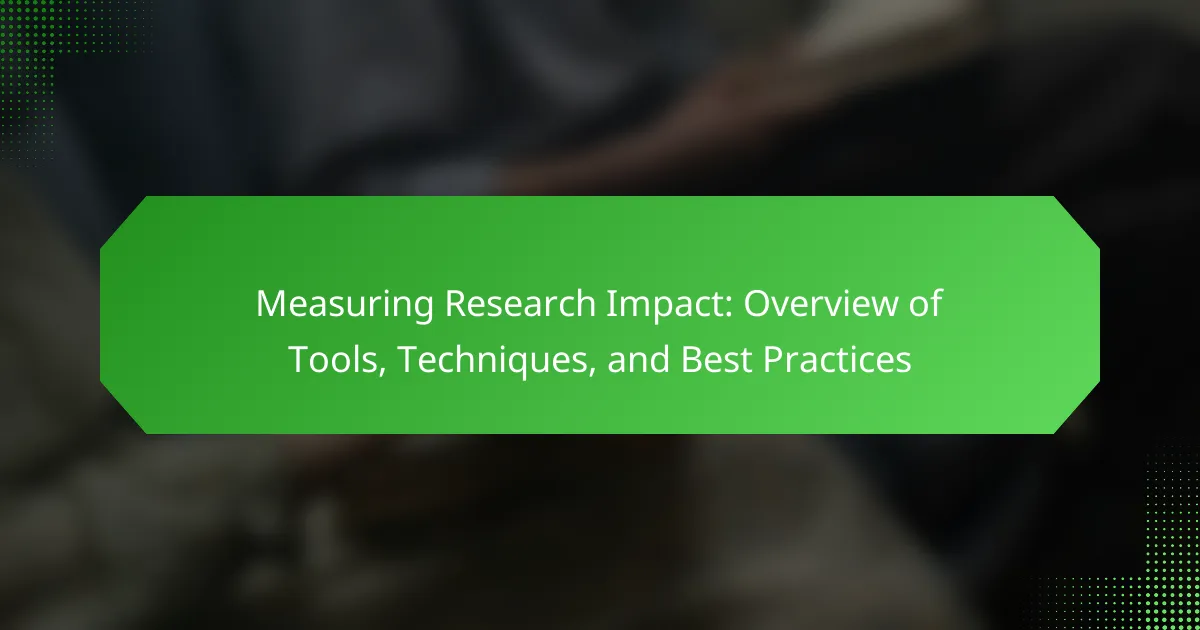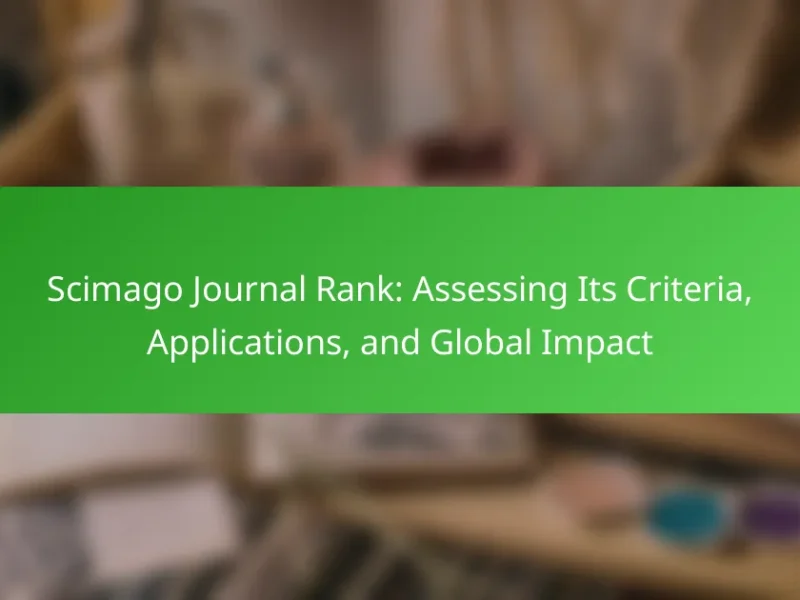Research Impact Measurement evaluates the effects of research activities on society, academia, and the economy through various metrics and methodologies. This article provides an overview of tools such as citation analysis, altmetrics, and bibliometrics, which assess how research influences policy, practice, and knowledge advancement. It discusses both quantitative techniques, like bibliometric analysis, and qualitative methods, such as case studies and surveys, to provide a comprehensive assessment of research impact. Key findings emphasize the importance of effective measurement in informing funding decisions and enhancing research quality. The article aims to equip readers with best practices for understanding and measuring the impact of research outputs.

What is Research Impact Measurement?
Research Impact Measurement evaluates the effects of research activities on society, academia, and the economy. It encompasses various metrics and methodologies to assess how research influences policy, practice, and knowledge advancement. This measurement can include citation analysis, surveys, and case studies to quantify impact. For instance, a study by the UK Research and Innovation (UKRI) highlights the importance of understanding research contributions to societal challenges. The study emphasizes that effective measurement can inform funding decisions and improve research quality.
Why is measuring research impact important?
Measuring research impact is important because it evaluates the effectiveness and relevance of research activities. This assessment informs stakeholders about how research contributes to knowledge, policy, and practice. Evidence shows that research with high impact can lead to increased funding and support. According to a study published in the journal Research Evaluation, impactful research significantly influences decision-making in various sectors. Additionally, measuring impact helps identify areas for improvement and guides future research directions. Ultimately, understanding research impact fosters accountability and enhances the visibility of scholarly work.
What are the key benefits of understanding research impact?
Understanding research impact provides several key benefits. It helps researchers demonstrate the value of their work. This is essential for securing funding and support. Understanding impact also informs future research directions. It allows researchers to align their work with societal needs. Additionally, it enhances collaboration opportunities with stakeholders. By measuring impact, researchers can refine their methodologies. This leads to improved quality and relevance of research outcomes. Ultimately, understanding research impact contributes to knowledge dissemination and public engagement.
How does research impact influence funding and policy decisions?
Research impact significantly influences funding and policy decisions by providing evidence that guides resource allocation. Policymakers rely on research findings to justify investments in specific areas. For example, studies demonstrating the efficacy of educational programs can lead to increased funding for those initiatives. Additionally, research impact metrics, such as citation counts and societal outcomes, help prioritize projects for funding. Organizations like the National Science Foundation utilize research impact assessments to shape policy frameworks. These assessments ensure that funding aligns with societal needs and scientific advancement. Overall, research impact serves as a critical tool for informed decision-making in funding and policy development.
What are the different dimensions of research impact?
Research impact encompasses various dimensions, including academic, economic, societal, and environmental impacts. Academic impact refers to the influence of research on further studies, publications, and knowledge advancement. Economic impact involves contributions to industry, job creation, and innovation. Societal impact signifies improvements in public policy, community well-being, and quality of life. Environmental impact relates to research addressing ecological issues and sustainability. Each dimension reflects how research translates into tangible benefits across different sectors, demonstrating its value and relevance in society.
How do academic, societal, and economic impacts differ?
Academic impacts focus on knowledge advancement and educational outcomes. They are measured through publications, citations, and the influence on future research. Societal impacts relate to the effects research has on communities and social practices. These impacts can be assessed through public engagement, policy changes, and community benefits. Economic impacts involve financial aspects, such as job creation and increased productivity. They are evaluated through metrics like funding generated, economic growth, and return on investment. Each type of impact serves a distinct purpose and is measured using different methodologies. Academic impacts emphasize scholarly contributions, societal impacts prioritize community improvement, and economic impacts concentrate on financial benefits.
What role does public engagement play in research impact?
Public engagement significantly enhances research impact. It bridges the gap between researchers and the community. Engaged public audiences can provide valuable feedback on research relevance. This interaction helps researchers align their work with societal needs. Moreover, public engagement fosters greater awareness of research findings. Increased awareness can lead to broader application of research outcomes. Studies show that engaged research often receives higher citations. Therefore, public engagement is a critical factor in amplifying research influence and effectiveness.

What tools are available for measuring research impact?
Tools for measuring research impact include citation analysis, altmetrics, and bibliometrics. Citation analysis evaluates the number of times a research work is cited in other publications. Altmetrics track the online attention a research output receives through social media, news articles, and other platforms. Bibliometrics uses statistical methods to analyze publications and their impact over time. Each tool provides different insights into research influence and reach. For instance, citation analysis is widely used in academia to assess the significance of scholarly articles. Altmetrics offer a broader view of impact beyond traditional citations.
What are the most commonly used metrics in research impact assessment?
The most commonly used metrics in research impact assessment include citation counts, h-index, impact factor, and altmetrics. Citation counts measure the number of times a research work is referenced in other publications. The h-index combines productivity and citation impact, indicating the number of papers with a certain number of citations. Impact factor reflects the average number of citations received by articles in a journal, providing insight into the journal’s influence. Altmetrics assess the online engagement and dissemination of research through social media, news outlets, and other platforms, capturing broader impact beyond traditional citations. These metrics are widely recognized for evaluating research quality and influence within the academic community.
How do citation indices contribute to measuring impact?
Citation indices quantify the impact of scholarly work by tracking the frequency of citations in academic literature. They provide a numerical representation of how often a work is referenced by other researchers. This frequency indicates the relevance and influence of the work within its field. For example, a high citation count suggests that the research has contributed significantly to ongoing discussions or advancements. Citation indices, such as the Web of Science and Scopus, aggregate citation data across various journals. They help researchers, institutions, and funding bodies assess the productivity and impact of research outputs. Additionally, citation indices can reveal trends in research areas by highlighting frequently cited works over time.
What is the role of altmetrics in understanding research reach?
Altmetrics play a significant role in understanding research reach by providing alternative metrics that capture the impact of research outputs. They measure engagement beyond traditional citations, including social media shares, mentions in news articles, and downloads. This broader scope allows researchers to assess how their work is disseminated and received by diverse audiences. According to a study published in PLOS ONE, altmetrics can correlate with traditional citation metrics, offering a more comprehensive view of research impact. Altmetrics also facilitate real-time tracking of engagement, enabling researchers to adapt their outreach strategies effectively. Overall, altmetrics enhance the understanding of research reach by highlighting various channels of engagement and their significance.
How can software and platforms assist in measuring research impact?
Software and platforms assist in measuring research impact by providing analytics and metrics for evaluation. They enable researchers to track citations, downloads, and social media mentions. Tools like Altmetric and Scopus provide insights into the reach and influence of research outputs. They aggregate data from various sources, offering a comprehensive view of impact. Additionally, platforms can visualize data trends and patterns over time. This helps in understanding the effectiveness of research dissemination strategies. By utilizing these tools, institutions can make data-driven decisions to enhance research visibility.
What features should researchers look for in impact measurement tools?
Researchers should look for several key features in impact measurement tools. These features include data accuracy, which ensures reliable results. User-friendliness is essential for ease of navigation and operation. Flexibility is important for adapting to various research contexts and methodologies. Integration capabilities allow the tool to work with existing systems and data sources. Customization options enable researchers to tailor the tool to specific needs. Reporting features should provide clear, actionable insights. Lastly, support and training resources enhance user experience and tool effectiveness. These features collectively contribute to the overall reliability and utility of the impact measurement tools.
How do data visualization tools enhance understanding of research impact?
Data visualization tools enhance understanding of research impact by transforming complex data into visual formats. These tools simplify the interpretation of large datasets. They allow researchers to identify trends and patterns easily. Visual representations can highlight key findings effectively. For instance, charts and graphs make comparisons clearer. They also facilitate communication of results to diverse audiences. A study by Knaflic (2015) emphasizes that visuals engage viewers and improve retention of information. This engagement leads to a deeper understanding of the research’s significance and implications. Overall, data visualization tools are essential in conveying research impact comprehensively.

What techniques are effective in assessing research impact?
Quantitative and qualitative techniques are effective in assessing research impact. Quantitative techniques include bibliometrics, which analyze publication and citation data. This method provides statistical insights into research output and influence. Altmetrics measure the online attention and engagement of research outputs. They capture mentions in social media, news, and policy documents. Qualitative techniques involve case studies and interviews with stakeholders. These methods offer in-depth insights into the practical implications of research. Surveys can also gauge the perceived value of research among practitioners. Combining these techniques yields a comprehensive assessment of research impact.
How can qualitative methods complement quantitative measures?
Qualitative methods can enhance quantitative measures by providing deeper insights into data. Quantitative measures offer numerical data that can show trends and patterns. However, they often lack context and understanding of underlying reasons. Qualitative methods, such as interviews and focus groups, can reveal motivations and experiences behind the numbers. This combination allows researchers to validate and enrich quantitative findings. For example, a study might show a drop in user satisfaction, while qualitative interviews can uncover specific issues driving that decline. Together, these methods create a more comprehensive understanding of research impact.
What are case studies and how do they illustrate research impact?
Case studies are in-depth analyses of specific instances or events that illustrate broader principles or outcomes. They provide detailed insights into the application and implications of research findings. By showcasing real-world examples, case studies demonstrate how research impacts practice, policy, or understanding in various fields. For instance, a case study on a health intervention can reveal its effectiveness in improving patient outcomes. This concrete evidence illustrates the tangible benefits of research. According to a report by the National Institutes of Health, case studies can bridge the gap between theory and practice, enhancing the relevance of research.
How can interviews and surveys provide insights into research effectiveness?
Interviews and surveys are valuable tools for assessing research effectiveness. They gather qualitative and quantitative data directly from participants. This data reflects the perceptions and experiences of those impacted by the research. For instance, interviews can reveal in-depth insights into how research findings are applied in real-world settings. Surveys can quantify these insights, providing statistical evidence of effectiveness.
Research by the National Science Foundation highlights that participant feedback is crucial for evaluating research outcomes. This feedback can identify strengths and weaknesses in research methodologies. Additionally, both methods can uncover areas for improvement, guiding future research efforts. Overall, interviews and surveys facilitate a comprehensive understanding of research impact.
What best practices should researchers follow when measuring impact?
Researchers should follow systematic methodologies when measuring impact. They should clearly define their research objectives and the specific impacts they aim to assess. Establishing relevant metrics is crucial for quantifying outcomes. Researchers must utilize both qualitative and quantitative methods to capture a comprehensive view of impact. Engaging stakeholders in the process can provide valuable insights and enhance relevance. Regularly reviewing and adjusting methodologies ensures that the assessment remains aligned with evolving goals. Transparency in reporting findings fosters trust and credibility in the research community. Adhering to ethical standards is essential to maintain integrity throughout the measurement process.
How can researchers ensure their impact assessment is comprehensive?
Researchers can ensure their impact assessment is comprehensive by employing a multi-faceted approach. This includes utilizing both qualitative and quantitative methods to gather diverse data. Surveys and interviews can capture stakeholder perspectives. Statistical analysis can quantify impact metrics effectively. Additionally, researchers should consider long-term and short-term impacts. They must also engage with relevant communities to understand broader implications. Regularly reviewing and updating assessment frameworks is essential for accuracy. A comprehensive assessment will incorporate various stakeholder inputs and contextual factors. This approach aligns with best practices in impact assessment, as highlighted by the UK Research and Innovation guidelines.
What common pitfalls should be avoided in research impact measurement?
Common pitfalls in research impact measurement include lack of clear objectives. Ambiguous goals lead to ineffective assessments. Another pitfall is neglecting stakeholder engagement. Involving stakeholders ensures relevant metrics are identified. Additionally, using inappropriate metrics can skew results. Metrics must align with research goals for accuracy. Overlooking context is also problematic. Contextual factors influence the interpretation of impact. Lastly, failing to communicate findings effectively hinders impact recognition. Clear communication enhances understanding and application of results.
What practical tips can enhance research impact measurement efforts?
To enhance research impact measurement efforts, establish clear objectives. Defining what success looks like helps focus measurement activities. Use a combination of qualitative and quantitative metrics. This provides a comprehensive view of impact. Engage stakeholders in the measurement process. Their insights can reveal additional dimensions of impact. Utilize established frameworks like the Research Excellence Framework (REF). This can guide effective measurement practices. Regularly review and adjust measurement strategies. This ensures they remain relevant and effective over time. Document and share findings transparently. This fosters trust and encourages collaboration in future research initiatives.
Measuring Research Impact is the primary entity of this article, which evaluates the effects of research activities on society, academia, and the economy. The article outlines various tools and techniques for assessing research impact, including citation analysis, altmetrics, and bibliometrics. Key dimensions of research impact—academic, economic, societal, and environmental—are discussed, along with their influence on funding and policy decisions. Best practices for comprehensive impact measurement, the role of public engagement, and common pitfalls to avoid are also highlighted, providing a thorough overview of how to effectively measure and enhance research impact.


